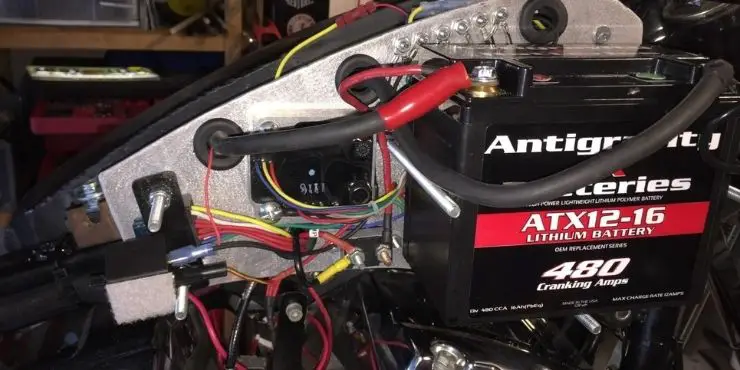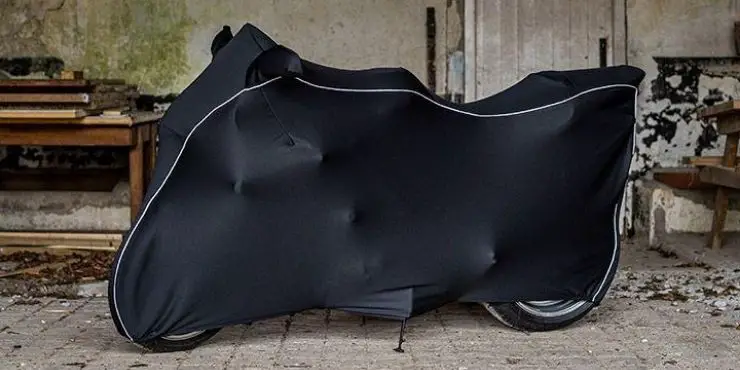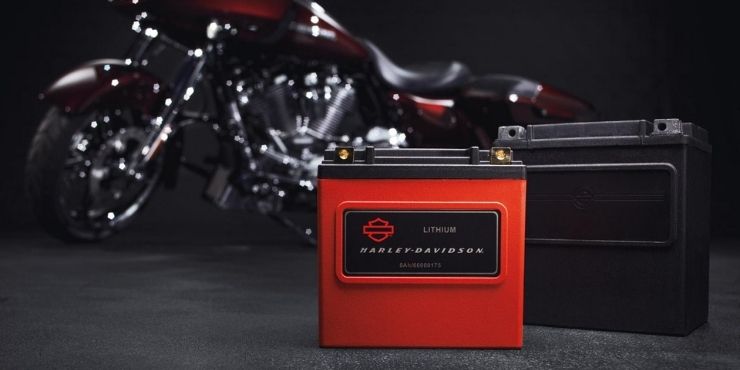Has your Harley-Davidson bike run out of batteries, and now you’re wondering what type of battery does Harley-Davidson use? If yes, then you’re in the right place. You’ll get the answer to that and so much more here.
The type of battery that Harley-Davidson use is any kind of battery designed for engines. Most models come with lithium batteries as this is what most users prefer. But you can also go for other options.
In this article, you will get to know all about what type of battery does Harley-Davidson use, who manufactures them, the pros and cons of lithium battery, and more. Continue reading to know more about Harley-Davidson batteries.
What type of battery does Harley-Davidson use?
The Harley-Davidson bikes can use any type of battery designed for their engine. However, it is recommended that you should use Lithium Li-Fe batteries as they have 2x more battery life than others. These batteries also feature more cranking amps as compared to the regular AGM batteries.
One of the primary selling points of lithium batteries is the lack of weight. Moreover, they’ll also come with a considerably higher cranking capability than the lead-acid AGM batteries. It means that for large capacity V-twin engines, lithium batteries will deliver more kick to the starter motor. This will give your bike a comparatively easier and faster start. The large majority of Harley-Davidson users and even manufacturers believe that lithium batteries are the best for these bikes.
It will also weigh considerably less than other types of batteries. The largest lithium battery used in Harley-Davidson bikes is used in the Road King model. Even this one saves almost 7.7 kg over the lead-acid AGM battery. This will make the bike far easier to maneuver, especially when you’re pushing it or riding at a low speed.
Who makes batteries for Harley-Davidson bikes?
The answer to who makes batteries for Harley-Davidson is East Penn Manufacturing. East Penn Manufacturing has become the official manufacturer tasked with manufacturing the batteries for Harley-Davidson bikes. Also known as Deka, East Penn Manufacturing won the rights from Yuasa, the previous and original Battery producer for Harley-Davidson. Although it has been a big hit for its portfolio, Yuasa still remains an OEM for many other brands including Yamaha, Kawasaki, and Honda. It isn’t entirely clear which year Deka took over the battery production rights from Yuasa. However, it is believed that it started sometime in the mid-to-late 2000s.
What are some common types of batteries used in Harley-Davidson bikes?
There are many different types of batteries that Harley-Davidson bikes use. However, the brand knows all the merits of lithium over lead-acid batteries. This is why Harley-Davidson bikes come with lithium batteries and the brand sells its own branded lithium motorcycle batteries. There are three Harley-Davidson lithium motorcycle batteries that cover the majority of Harley-Davidson bikes. There are some exceptions such as the V-Rod run batteries found in Japanese models. The three types of batteries are rated at 4Ah, 6Ah, and 8Ah. They come in similar physical sizes but the number of cells in them is different. This is what determines the cranking power and amp-hour rating.
The cranking ability of a battery is also very important as this is what gets the motor running. This will also give an indication of the power stored in the battery. Further, it’ll also determine how long the battery can run the motorcycle’s electrics and add-on items. Unless you’re spending a long time with the ignition on and the radio playing, the Ah won’t make much difference.
Lithium LiFe 4Ah battery
The Lithium LiFe 4Ah battery is a powerful and long-lasting battery option for your Harley-Davidson bike. Not only does it give more cranking amps than an AGM battery, but it is also 17lbs lighter.
The lightweight lithium-ion technology in the battery offers 2x the runtime compared to standard lead-acid batteries. Moreover, it also provides reliable starting power in most conditions. It will also make less noise even if you go down hills or suddenly stop at speed.
Lithium LiFe 6Ah battery
Lithium batteries are capable of storing energy for a long time. This is why you won’t have to worry about lighting or audio going dead when riding the bike. The Lithium LiFe 6Ah battery will be maintenance-free and come with high-quality brass terminals. It essentially means that these beasts will work flawlessly, even if you’re looking to speed around in rigid conditions. However, that isn’t an invitation to carelessly ride your bike in ways that it shouldn’t be driven.
Lithium LiFe 8Ah battery
Lithium LiFe 8Ah batteries will come with an impressive lifespan of over double of Harley-Davidson AGM batteries when maintained properly. They will not lose any charge during storage even if disconnected from the bike. Moreover, they’ll utilize 85% Amp Hour capacity as compared to just 10% of AGMs. This means they’ll deliver more power to your accessories like lighting and audio as compared to AGM batteries.
Pros and Cons of lithium batteries for Harley-Davidson bikes
Lithium batteries aren’t just for racing bikes. They are perfect for Harley-Davidson motorcycles. These will come with a higher cranking capability as compared to standard lead-acid AGM batteries. It makes life very easy for the rider as these batteries start the bike easily and quickly.

But does it mean lithium batteries are flawless and come with no negatives when used with Harley-Davidson bikes? Not at all. There are certain pros and cons of using lithium batteries for Harley-Davidson bikes that you should keep in mind.
Pros of using lithium batteries on Harley-Davidson motorcycles
- Lithium batteries come with a power density of 3-4 times higher than lead-acid AGM batteries. This means lithium batteries are considerably lighter, sometimes just 25% of the weight of lead-acid batteries.
- Lithium batteries will not contain any acid, which means there is zero possibility of acid leaks.
- These batteries come with a cranking power 2x that of a lead-acid AGM battery.
- Lithium batteries come with a lower self-discharge rate as compared to lead-acid batteries. The exact rate is approx. 3-5% per month.
- Lithium batteries will charge much faster than standard batteries (almost 3 hours as compared to 12 hours for the standard batteries).
- Lithium batteries are extremely durable. They can easily last around 5 to 10 years. Meanwhile, lead-acid AGM batteries only last around 2 to 3 years. This makes the former a better value for money.
Cons of using lithium batteries on Harley-Davidson motorcycles
- You will not be able to charge a lithium battery using a lead-acid battery charger.
- They are a lot more expansive than the equivalent lead-acid batteries (approx. 30%).
- Lithium batteries struggle to perform well at temperatures below or close to freezing temperatures.
- A charger that isn’t designated for Lithium batteries will likely damage the battery by introducing too much voltage.
- A flat lithium battery is unlikely to be recovered, as it takes a long time for these batteries to self-discharge. Once it is done, there is no bringing it back to life.
6 important tips to ensure your Harley-Davidson lithium batteries last longer
1. Park your Harley-Davidson motorcycle in a covered parking space
Parking in a covered, insulated parking space won’t just protect your bike and the paint job, it’ll also protect the battery. The cover and insulation prevent the external elements from getting through to the battery. By default, the battery will be protected by the panels surrounding it. However, sometimes the rubber on the seals of the panels corrodes and disintegrates, exposing the battery to moisture.

In case you reside in cold climates, a rapid decrease in temperature could cause the battery to suddenly go flat. The chances of this happening are even higher if the Harley-Davidson bike is parked outdoors. Covered parking spaces will keep your Harley-Davidson and its battery properly covered and cared for.
2. Keep the battery terminals clean and properly greased
The battery terminals can accumulate dirt, muck, and grime fairly easily. After that, they start oxidizing and corroding. Eventually, they’ll reduce the charging in the battery. You should make sure that the terminals and the electrodes in the battery are properly cleaned and greased during servicing.
3. Keep the lithium battery safe and secure
Lithium batteries will come with a strap holding them in place. You must make sure that the strap is in place; otherwise the battery will move around in the mounting bracket. Loose and unsecured batteries come with a risk as they could start cracking and cause complications. They might end up doing irreparable damage to the bike’s bodywork.
Make sure that the mounting bracket housing the battery is clean of any dirt and debris. Moreover, it needs to be free of rust. Lastly, make sure that the battery is firmly seated in the mounting bracket with the terminals firmly connected.
4. Disconnect the battery if it isn’t being used
The basic principle for not just Harley-Davidson bikes, but any vehicle is that the engine powers them. The batteries are used for providing power in the self-start system and for lighting once the engine is off. As a result, many bikes are designed to charge the battery when you ride. To ensure that the battery lasts longer, disconnect its terminals in case you don’t have plans to ride your bike. If you think that your bike won’t be used for 15 days or more, then you should disconnect the terminals.
5. Keep a spare battery charger
Having a spare battery charger would be a handy addition for riders who use the bike on an infrequent basis. It will help save the battery from the memory effect. Further, it’ll also ensure that the battery remains topped up from the power grip. Hence, this will save you engine wear and fuel cost.
6. Let the battery breathe
The battery needs to be well ventilated. The venting pipes and vent holes must be kept clear and open. Blocked vents or pipes can often lead to the buildup of unwanted dirt, and this can be potentially deadly. The buildup could lead to the battery exploding or bursting. Giving your battery enough opportunity to breathe will giving a better performance and a longer lifespan.
Conclusion
Thank you for reading. Hopefully, now you have a better understanding of what type of battery does Harley-Davidson use. Harley-Davidson motorcycles predominantly use lithium batteries, while some models also have lead-acid AGM or other types of batteries. Lithium batteries are considerably lighter, while also give 2x more powerful performance. It is important to maintain and take care of the lithium batteries so that you can get a long lifespan from them.


